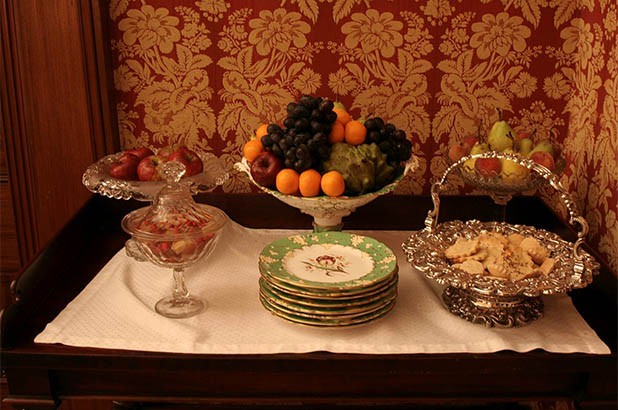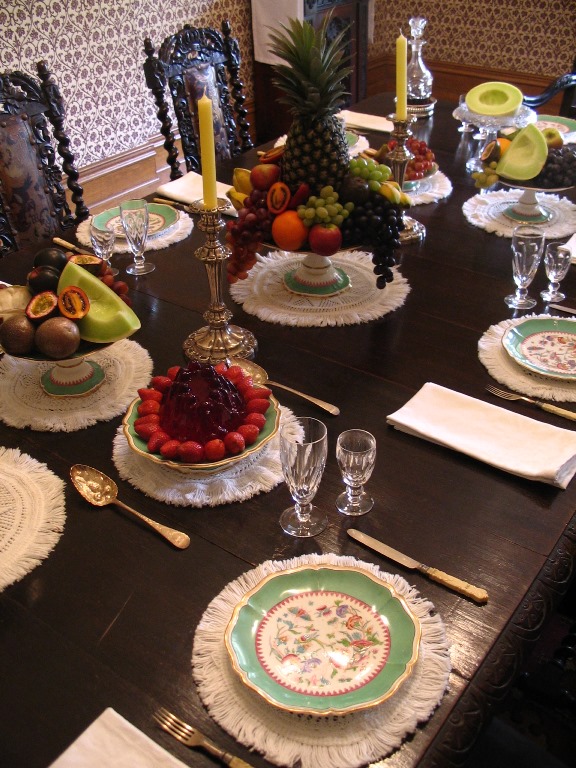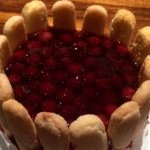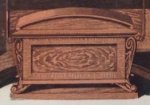With the second course finished, it’s time for some precision table acrobatics as we re-set the table for dessert.
An excellent description of the dessert course ‘a la Francais’ in the second half of the 1820s is given by one of my favourite diarists, Prince Hermann von Pückler-Muskau (1785 – 1871), a German aristocrat who was a particularly detailed observer of customs, architecture and landscapes, and a landscape designer to boot. This was, after all, the great age of letter writing and diarists, far removed from today’s sms abbreviations! Here is his description of a dessert in the English manner. Admittedly what he describes are dinners in the highest of houses – so when he says ‘inferior’ it could actually be referring to quite a wealthy household – but the principles are the same.
At the conclusion of the second course comes a sort of intermediate dessert of cheese, butter, salad, raw celery, and the like; after which ale sometimes thirty or forty years old, and so strong that when thrown on the fire blazes it like a spirit, is handed about. The table cloth is then removed: under it, at the best tables, is a finer, upon which the dessert is set. At inferior ones, it is placed upon the bare polished table. It consists of all sorts of hot-house fruits, which are here of the finest quality, Indian and native preserves, stomachic gingers, comfitures and the like. Clean glasses are set before every guest, and, with the dessert plates and knives and forks, small fringed napkins are laid [ie doilies]. [1]
Note the line “The table cloth is then removed”? In ‘inferior’ houses like Elizabeth Bay House the table is actually stripped down to the polished mahogany, then reset with knitted doilies on which are placed the new plates, cutlery and serving dishes. What I wish he described though is what the diners did at this point. Do they all stand and stretch their legs (and stomachs)? Do the servants perform an intricate series of acrobatic manoeuvres around them while they’re seated? I particularly like one servants’ guide that advises how to stand with your feet braced so as to remove the heavy epergne without tumbling face-first onto the table. Here’s a table layout from The footman’s guide; like the previous courses the arrangement is still ordered and symmetrical. Note the decorative clam-shell shapes of the serving dishes:
![Diagram for the layout of the dessert (third) course, from James Williams, The footman's guide, Dean and Munday, London, [ca.1845] Diagram for the layout of the dessert (third) course.](../../app/uploads/sites/2/2013/06/369x592xDessert-for-fourteen-Footmans-Guide-formatted.jpg.pagespeed.ic.BCqH-Bsq41.jpg)
Diagram for the layout of the dessert (third) course, from James Williams, The footman’s guide, Dean and Munday, London, [ca.1845]
At Elizabeth Bay House during its first decades much of the dessert would already have been on show throughout the meal, arranged in a tantalising display on a serving table. We know that the Macleays’ dining room had two of these tables, in addition to a sideboard. Those you see in the house today were, like Elizabeth Bay House itself, designed in the office of the architect/builder John Verge, for the dining room of another great colonial house – ‘Vineyard’. Here’s a dessert laid out in a recreation at Vaucluse House – using bright green dessert ware provenanced to the Wentworth family: fresh and preserved fruits and grapes, sweet jellies, biscuits and assorted nuts.
If you’re up for a Victorian dessert, why not try Isabella Beaton’s recipe for meringues. Hollowed out, filled with flavoured cream and joined together they’re effectively what we now call ‘kisses’ or, if made with almond meal, macaroons (there’s nothing new under the sun). The meringues served at William Sharp Macleay’s dinner would have been very similar to these.
Mrs Beeton’s meringues
INGREDIENTS – 1/2 lb. [225grams] of pounded [castor] sugar, the whites of 4 eggs [55 – 60 gram] eggs [, baking paper. Warm oven to 175C.]
Mode—Whisk the whites of the eggs to a stiff froth [i.e. till stiff peaks form], and, with a wooden spoon, stir in quickly [add sugar a little at a time] the pounded sugar; and have some boards thick enough to put in the oven to prevent the bottom of the meringues from acquiring too much colour. Cut some strips of paper about 2 inches wide; place this paper on the board, and drop a tablespoonful at a time of the mixture on the paper, taking care to let all the meringues be the same size. In dropping it from the spoon, give the mixture the form of an egg, and keep the meringues about 2 inches apart from each other on the paper. Strew over them some sifted sugar, and bake in a moderate oven [175 Celsius / 350 Fahrenheit, but each oven varies] for 1/2 hour. As soon as they begin to colour, remove them from the oven [if you were making unfilled meringues you would turn off the oven and leave the door ajar to cool]; take each slip of paper by the two ends, and turn it gently on the table, and, with a small spoon, take out the soft part of each meringue. Spread some clean paper on the board, turn the meringues upside down, and put them into the oven to harden and brown on the other side. When required for table, fill them with whipped cream, flavoured with liqueur or vanilla, and sweetened with pounded [castor] sugar. Join two of the meringues together, and pile them high in the dish… To vary their appearance, finely-chopped almonds or currants may be strewn over them before the sugar is sprinkled over [i.e. before they are cooked. A variation is to spike the meringues with slivered almonds to resemble a ‘hedgehog’]; and they may be garnished with any bright-coloured preserve. Great expedition is necessary in making this sweet dish; as, if the meringues are not put into the oven as soon as the sugar and eggs are mixed, the former melts, and the mixture would run on the paper, instead of keeping its egg-shape… Sufficient to make 2 dozen meringues.
This recipe is from Isabella Beeton, Beeton’s book of household management, London, 1861, from the Rouse Hill House collection.
References
[1.] Fürst Hermann Von Pückler-Muskau (1785 – 1871), Tour in England, Ireland, and France: in the years 1826, 1827, 1828, and 1829. With remarks on the manners and customs of the inhabitants, and anecdotes of distinguished public characters. in a series of letters by a German prince, Carey, Lea & Blanchard, Phildelphia, 1833




